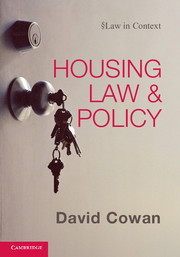Part I - Regulation of housing tenure
Published online by Cambridge University Press: 05 June 2012
Summary
Introduction to Part I
This part of the book considers the ways in which each of the housing providers in the identified tenures – owner-occupation, private renting, local authority and PRP – has been and are regulated. ‘Housing providers’ in this context means not only those who are actually responsible for the provision of housing but also those who facilitate it. For example, public and private finance plays a crucial role in the regulation of all housing providers and this is reflected in the succeeding chapters. Public finance has been gradually drying up since the 1970s and the housing system has begun to draw upon private finance in increasingly innovative ways. As that market has been deregulated, the provision of finance has become more complex and financiers have (for example) sought to impose private sector disciplines on the provision of social housing. The marketisation of social housing is reflected both in the regulation of its development and consumption. To take one example, the importation of ‘direct line’ methods into social housing (‘one call does it all’) is a by-product of these changing structures and identities. The marketisation of private housing has been reflected in changing regulatory and institutional structures. This complexity is important for it shows the critical role that central government has had in influencing the development and/or regression of each tenure. However, this part is also concerned with regulation from diverse sources, not just central government. The most significant changes in regulation have occurred from unexpected sources beyond the state, and this part takes account of these sources, particularly as they have affected the development of tenure. Indeed, what this part begins to unpick is how, despite regulatory differences between tenures in the social sector, these differences are becoming regarded as unsustainable because of the significant cross-over between those tenures.
- Type
- Chapter
- Information
- Housing Law and Policy , pp. 27 - 28Publisher: Cambridge University PressPrint publication year: 2011



